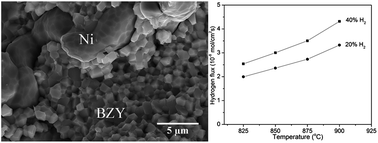A sinteractive Ni–BaZr0.8Y0.2O3−δ composite membrane for hydrogen separation†
Abstract
BaZr0.8Y0.2O3−δ (BZY) is an excellent candidate material for hydrogen permeation membranes due to its high bulk proton conductivity, mechanical robustness, and chemical stability in H2O- and CO2-containing environments. Unfortunately, the use of BZY as a separation membrane has been greatly restrained by its highly refractory nature, poor grain boundary proton conductivity, high number of grain boundaries resulting from limited grain growth during sintering, as well as low electronic conductivity. These problems can be resolved by the fabrication of a Ni–BZY composite membrane with large BZY grains, which requires the development of a sinteractive Ni–BaZr0.8Y0.2O3−δ materials system. In this work, Ni–BZY composite membranes have been fabricated by three methods: (i) a combined EDTA-citric method, (ii) a solid state reactive sintering method, and (iii) a solid state reaction method. The effects of different fabrication methods on the sintering activity, microstructure, and phase composition have been systematically investigated by dilatometry, scanning electron microscopy, and powder X-ray diffraction. After reduction, only Ni–BZY membranes prepared through the solid state reaction method were observed to be dense with large BZY grains (∼1 μm). It has been found that the densification and grain growth of Ni–BZY composite membranes were controlled by the method and sequence of NiO introduction during composite membrane processing. After process optimization, a 0.44 mm-thick Ni–BZY dense composite membrane was fabricated using the solid state reaction method which exhibited a hydrogen flux of 4.3 × 10−8 mol cm−2 s−1 in wet 40% H2 at 900 °C, significantly higher than those of non-BaCeO3-based hydrogen separation membranes.


 Please wait while we load your content...
Please wait while we load your content...